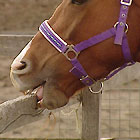Dr Paul McGreevy, from the Faculty of Veterinary Science at Sydney University, is a specialist in animal behaviour and welfare science. Recently, he and his research colleagues have been looking at the incidence, cause and effects of stereotypic behaviour, such as crib-biting and wind-sucking, in stabled horses. Don spoke with Dr McGreevy about the research and its management implications for horse owners.
What is crib-biting?
Crib-biting is when a horse repeatedly bites fixed objects with its incisor teeth. It then pulls back making a characteristic grunting noise, called ‘wind-sucking’. Stabled horses may do this around 8,000 times per day. This behaviour has always been regarded as a ‘vice’ of the horse, and has been linked to various forms of ill-health including worn teeth, colic, stomach ulcers, hypertrophy of the muscles of the ventral neck, and a failure to maintain body weight.
Crib-biting horses are often subjected to surgical or mechanical prevention methods, which can cause pain and distress and do not address the cause of the problem. Crib-biters are thought to be of very little value, and so many are destroyed.
Why horses crib-bite
Dr McGreevy and his colleagues think that abnormal stable behaviours indicate that there’s a problem with the horse’s environment. Also that crib-biting, which affects about 1 in 10 stabled horses, occurs when horses are denied the opportunity to graze. The horse has evolved to chew for up to 16 hours per day, but stabled horses consume their concentrated rations in a few hours and this causes a build-up of acid in the stomach.
Radiographs of crib-biters showed that there is no movement of the tongue as in true swallowing. Instead there is an explosive distension of the oesophagus without evidence of air passing into the stomach. So it is possible that horses crib-bite after a concentrated meal to improve gut motility.
The researchers also proposed that crib-biting may be a way for horses to produce saliva. Saliva buffers excess stomach acid, but saliva production in the horse is a physical process that depends on pressure being exerted on the parotid salivary gland. So these horses may actually have a biological need to crib-bite.
Implications for owners
Horse owners need to reappraise their management practices and use alternative and humane methods to prevent the development of crib-biting. Specifically they could look at ways of increasing forage time, for example providing hay ad-lib or using a hay net with smaller holes. Providing antacid diets may alleviate gastric discomfort and reduce crib-biting. Increasing grazing time and social interaction between horses is also recommended.
(Note: antacid diets are not yet commercially available and not permitted by horse racing codes.)
Further reading
Handle With Care, by Dr Paul McGreevy. Published by Halstead Press, ISBN 1 875684 76X. RRP $27.95.
Equine Behaviour: a guide for veterinarians and equine scientists, by Dr Paul McGreevy. Published by Harcourt Press.



